Artificial Trans Fat: A Timeline

Artificial trans fat dates back to the early 1900s, when German chemist Wilhelm Normann found that liquid vegetable or fish oils could be treated with hydrogen gas to make them solid or semi-solid. Versatile, long-lasting, and cheaper than animal fats such as butter, beef tallow, or lard, partially hydrogenated oils quickly became popular in the form of margarine, shortening, and frying oils.
Partially hydrogenated oils were long believed to be safe, and indeed were assumed to be healthier than the animal fats they sometimes replaced. While preliminary human and animal studies in the 1970s and 1980s suggested that trans fat promoted heart disease, 1976 and 1985 reviews commissioned by the Food and Drug Administration concluded that the overall evidence indicated that partially hydrogenated oils and trans fat were not harmful. By the early 1990s, however, clinical and epidemiology studies established clear-cut evidence that industrially produced trans fat caused heart disease. Like saturated fat, trans fat increases levels of LDL, or the “bad,” cholesterol, which promotes heart disease. But unlike saturated fat, trans fat also lowers HDL, the “good” cholesterol that is associated with a lower risk of heart disease.

